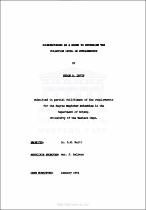| dc.contributor.advisor | Raitt, L M | |
| dc.contributor.advisor | Aalbers, J | |
| dc.contributor.author | Davis, Shaun Andre | |
| dc.date.accessioned | 2023-06-21T09:03:28Z | |
| dc.date.available | 2023-06-21T09:03:28Z | |
| dc.date.issued | 1991 | |
| dc.identifier.uri | http://hdl.handle.net/11394/10325 | |
| dc.description | >Magister Scientiae - MSc | en_US |
| dc.description.abstract | A pollution survey was done in Stellenbosch, along two transects. One was south-east and the north-east of the Oorrobrick brickfield the focal point of this study. Pine and Oak trees, chasman the leaves and lichens were used as bio-indicators for this survey. The levels of fluoride and sulphur decreased with distance from the main pollution source. Exceptionally high levels were recorded in the pine and oak trees within 1.5. km from the brickworks. The availability of calcium and magnesium in the leaves of pine and oak trees appeared to be negatively affected due to their binding with F- to form insoluble compounds. The brickfield proved to be a major source of especially copper and iron, as their levels in the bark material decreased with increasing distance. Lead levels were found to be correlated with vehicular traffic in the area. There was some evidence that the iron levels were also linked to the lead concentrations in the bark. | en_US |
| dc.language.iso | en | en_US |
| dc.publisher | University of the Western Cape | en_US |
| dc.subject | Stellenbosch | en_US |
| dc.subject | Environmental monitoring | en_US |
| dc.subject | Population | en_US |
| dc.subject | Transects | en_US |
| dc.subject | Biomonitoring | en_US |
| dc.title | Biomonitoring as a means to determine the pollution level in Stellenbosch | en_US |
| dc.type | Thesis | en_US |
| dc.rights.holder | University of the Western Cape | en_US |

